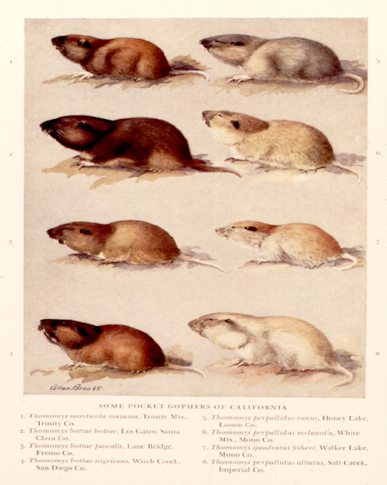 |
Historic
DNA Phylogeography
Historical DNA Analysis
The Berkeley Museum of Vertebrate Zoology houses hundreds
of thousands of specimens of vertebrates preserved as skins
and crania, or as whole bodies in alcohol. For many of the
species in the collection, populations have been well sampled
from the same localities multiple times over the course of
the last century. New forensic DNA techniques combined with
genomics approaches to developing genetic markers have informed
and stimulated new research among MVZ researchers. Several
current and planned projects have the goal of optimizing DNA
extraction and amplification methods from the preserved tissues.
Successful development of new single nucleotide polymorphism
(SNP) markers promise to allow relatively reliable genotyping
from these degraded DNA samples. SNP development from genomic
DNA libraries allows optimization of neutral, as well as non-neutral
markers that are widely dispersed throughout the genome. These
markers can be genotyped from very small amplicons, a feature
that is likely to maximize our ability to genotype museum
specimens.

One of the projects currently underway is investigating a
100-year sample set of pocket gophers (Thomomys bottae) to
address long-standing questions regarding genetic change in
populations over time and in response to environmental alterations.
More than 11,000 museum specimens of this species have been
collected in California, with sample sizes ranging from 230
to over 2800 per decade over the last 100 years. Although
every specimen will not be genotyped, such a large pool of
specimens will permit the design of an ideal time-series experiment.
The MVZ Museum Informatics Project has georeferenced and digitized
the sample data for museum specimens; with these data combined
with that available in public databases, we can characterize
the collection sites and their changes through time, specifically
according to specimen collection records, and regional histories
of land use, agricultural trends, geology, hydrology, and
human population expansion. Many previous studies of the ecology,
genetics, morphological variation, and systematics of this
species of pocket gophers have been carried out, providing
invaluable background knowledge from which to develop hypotheses
for the current study. Using the museum specimens as a source
of DNA for modern genetic analysis, we can actually observe
the patterns of genetic change concurrent with environmental
change over a century, rather than merely infer historical
processes from modern observations.
|
 |
